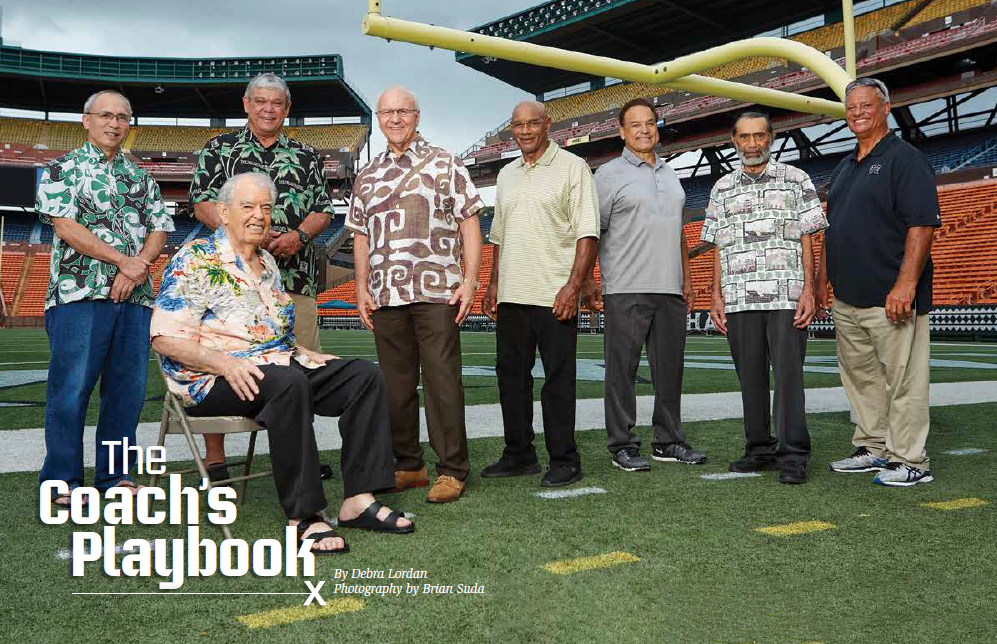 His handsome face and brilliant smile are instantly recognizable. Larry Price, Hawai‘i’s longtime radio and TV personality, and celebrated scholar-athlete, is a legendary icon — one of the islands’ treasured human resources. He is a quiet man who means what he says and says what he means — a multidimensional man with a passion for encouraging others to find their power and attain success through education and hard work.
His handsome face and brilliant smile are instantly recognizable. Larry Price, Hawai‘i’s longtime radio and TV personality, and celebrated scholar-athlete, is a legendary icon — one of the islands’ treasured human resources. He is a quiet man who means what he says and says what he means — a multidimensional man with a passion for encouraging others to find their power and attain success through education and hard work.
He has earned multiple advanced degrees. He also found success in many sports, as a player, coach, mentor and advocate. He studied martial arts, earning black belts in a number of disciplines. He was also an award-winning boxer during his eight-year stint in the Army. But his vast oeuvre includes much more than sports. He is also an accomplished musician, published author, college professor, political columnist, government administrator, small business management program director, sought-after motivational speaker, generous philanthropist and valued advisor.
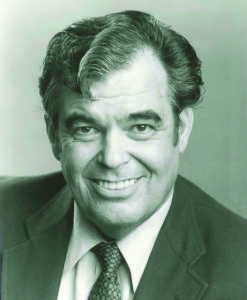 But without hesitation, Coach Price says his most beloved career was coaching football at the University of Hawai‘i, first as a defensive coordinator and then as head coach of the Rainbow Warriors from 1974 to ’76.
But without hesitation, Coach Price says his most beloved career was coaching football at the University of Hawai‘i, first as a defensive coordinator and then as head coach of the Rainbow Warriors from 1974 to ’76.
Although the popular Hawai‘i broadcaster may be best known to many as a media personality, the depths of his knowledge, experience and many talents warrant exposition. A cursory internet search will reveal a vast amount of information about his many achievements. But what his former players and assistant coaches say about him here may give us more insight into his character. The mere mention of his name opened a floodgate of memories from the players and coaches who will forever hold him in high esteem.
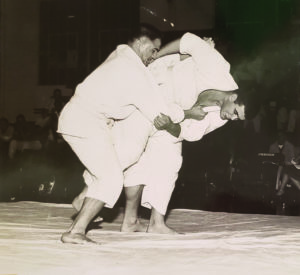
‘Many are called; few are chosen.’
If diamonds are made by applying pressure to coal, Coach Price’s football players are the crown jewels of UH football. Coach whipped his players into top shape each week with a brutal training regime, leading his aggressive Warriors onto the gridiron each weekend.
“It’s important for a coach to select the right guy to perform certain tasks,” says Coach. Coach Price used his own innate abilities to recognize and identify each player’s gifts, potential, possibilities and contributions, enabling them to tap into their own personal driving force that came from their hearts. His strong leadership pulled players toward a deep belief in themselves.
His team was a meritocracy, where meeting high standards with hard work paid off. Although Coach Price’s expectations were high, the rewards were great, both on and off the field.
“Saying the right thing at the right time is an art,” said Coach Price, who often used idioms and proverbs to motivate his team. For those who responded both physically, mentally and spiritually, “Many are called; few are chosen” had a life-changing impact. They were members of the traveling team — the chosen.
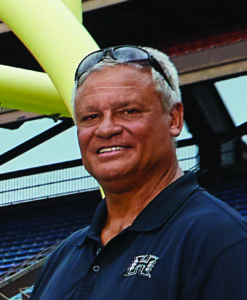 ‘We’re going to battle tonight.’
‘We’re going to battle tonight.’
Coach Price says he viewed the football field as a battlefield. His Warriors prided themselves on winning the physical side of the game.
Cliff LaBoy, a Farrington High School graduate, played football at Washington State for one year before returning to Hawai‘i. Coach Price called him “out of the blue.” Cliff became the left defensive end from 1972 to ’75, when Coach Price was a defensive line coach, then head coach.
“Coach was very straightforward and serious — a no-nonsense kind of guy,” says Cliff. “You either listened or you paid for it. He made sure we focused on our grades and he worked us very hard to get us to be the best we could be. His style of play was speed, physical and being technically sound at all positions. Back in the day, UH had the best defensive team than you can imagine. We beat a lot of big schools because of the strength of our defense.”
Even if they lost, UH prided themselves on winning the physical side of the game. “We worked so hard and we were in such great shape that we wouldn’t even be tired at the end of the game. Coach Price made sure of that.”

“He was an excellent defensive coach. He could take an ordinary player and get him to play at a higher level. He gets so deep inside of your head, that he can tell you what’s in there. He could see the potential in us all even though we were so kolohe.”
“But when he started chewing on that cigar tip, with that big smile of his… you knew you were in trouble. ‘OK, today Richardson and LaBoy are going to donate their bodies for the team.’ We had to do 1,000-yard bear crawls. It was an impossible task, but we always finished.”
There were a lot of Richardsons and LaBoys on the team. “But he knew when Saturday night came, all he had to do was turn us loose and we would perform for him.”
“‘We’re going to battle tonight. We take no prisoners. Whatever is in front of you, destroy it on your way to the ball,’ Coach would say. He would get you so pumped. We loved it.”
“He taught us to be strong and positive, and never give up. He taught us to work hard toward our goals and everything will fall in place. The things he instilled in us really helped me in my life. He changed us kolohe players into good human beings who contribute to our communities. We all respect that man so much.”
 ‘I will take you to a place where you’ve never been before.’
‘I will take you to a place where you’ve never been before.’
Practice and play with Coach Price included the whole player — body, mind and spirit — as he propelled them to “a place where they had never been before.”
Coach was the head coach when Mike Perkins started as a free safety in 1974. “I was only 5-foot-8 and 150 pounds. Coach Price gave me the opportunity to play for UH and prove to him and myself that I belonged on the field. I was never going to disappoint him,” says Mike.
Coach Price’s own coach at Roosevelt High School, Kato Chung, also gave Larry “a place in the game,” despite his small size at that time. Coach passed that forward, giving players with identifiable potential the opportunity to prove themselves.
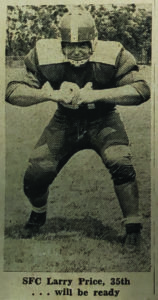 “I will always remember Coach Price saying, ‘I will take you to a place where you’ve never been before.’ I didn’t understand that until I started playing for him,” says Mike. “‘There is no way I can do this,’ I used to think. But when you are going through the grueling drills he made us do, he would take you to a place where you had never been before. It made all of us physically and mentally tough.”
“I will always remember Coach Price saying, ‘I will take you to a place where you’ve never been before.’ I didn’t understand that until I started playing for him,” says Mike. “‘There is no way I can do this,’ I used to think. But when you are going through the grueling drills he made us do, he would take you to a place where you had never been before. It made all of us physically and mentally tough.”
“Although he recruited mainland players, he wanted the local boys to do well. He would have high expectations of you. And nobody wanted to disappoint Coach Price. He was a guy that you sometimes hated, because he put you through so much. But you couldn’t play for anybody better. He got us to believe in ourselves and what we could do. I would go to war for the guy. That’s the kind of impact he had on his players. To this day, we would do anything for him.”
“I took those lessons and applied them in life after football. They are things I will never forget — the harder you work, the greater your success and the greater the benefits.”
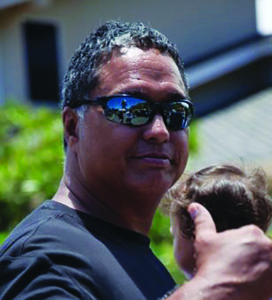 ‘The greatest motivational factors are love and fear.’
‘The greatest motivational factors are love and fear.’
Coach Price had a gift for motivating his players, driving them to exceed normal expectations both on the field and off.
Dexter Gomes played for Coach Price as a middle linebacker between 1970 and ’75.
“What I remember best is when he said, ‘The greatest motivational factors are love and fear,’” a phrase he adopted from the Bible. “If you could scare your players into playing for you, you might be able to motivate them, but it worked the other way, too. We gave the last drop of our blood to perform for him because we loved him that much — for all he did for us,” says Dexter.
“Back in the old days, coaches used to berate their players. They all thought they had to be so hard. The greatest thing I learned from Coach Price is that all you have to do is treat people with respect to get them to want to perform for you. It doesn’t just apply to coaching; it applies to everyday life. It all boils down to respect and treating people how you want them to treat you.”
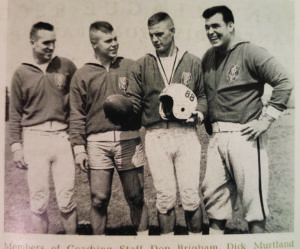
“Back in the days when we played, it wasn’t like today. It was physical. Everything back then was three yards and a cloud of dust — everything was done in the trenches. When you got into the third and fourth quarter, if you weren’t in shape, the other team could take advantage.” Coach Price made sure the team could go the distance… and then some.
“He had a saying, especially when we didn’t live up to his expectations: ‘Today you are going to run to the horizon. The horizon is as far as you can see, but you will never reach it. Get on the line!’ We ran until guys were falling on the ground. ‘Jump over them!’ Coach Price ordered.
It was not punishment; it was for the betterment of each of us and for the team.” “But I’ll tell you this, when the offense across from us was sucking wind, that’s when we knocked them out and dragged them into the deeper waters. When we pulled off some big games, we’d see that everything Coach Price said worked. We believed and trusted him.”
“There were a lot of life lessons. That is what he was all about. A lot of times I reflect on what he used to say and do.”
Coach Price kept his players in line by making football fun, using his dry wit to “keep it interesting.”
Former UH defensive end Pat Richardson was a member of the 1973 Rainbow Warriors team that beat Washington 10-7 in an epic competition.
“Coach Price made football fun. He made practice fun. You would never know what he was going to say. He made everything interesting. He would give you that look of death, but he’d be smiling at the same time with his nice bright white smile and stogie in his teeth,” says Pat. “He did things that would make everybody laugh.
“I motivated the players by putting everything in the form of a challenge,” says Coach.
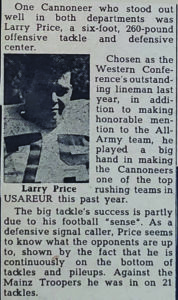 “The better shape you are in, the less your chance of getting seriously injured,” Pat says about the coach’s rigorous practices.
“The better shape you are in, the less your chance of getting seriously injured,” Pat says about the coach’s rigorous practices.
Disciplinary action also involved conditioning. When Pat accidentally stepped on Coach’s stogie that he had put on the ground for safe keeping, Coach said, ‘Run.’ “How long?” Pat asked. “Until I tell you to stop,” Coach replied. “Although I was suffering, Coach would say, ‘Don’t you ever quit on me.’ And we never would.”
“Local boys from Waianae, Makaha, Nanakuli, Aiea and Farrington played for him… they didn’t have a lot of money, but they gave us a good education, took us to the mainland, gave us good uniforms and a beautiful stadium — and all because of him — because Coach Price had a dream about Rainbow football.”
“He took all us local boys to another level. When we would mess around, we would pay the price more than the mainland players, because we should know better,” Pat says. “He expected more from his local players. He was hard on us when we deserved it — hard and fair.”
“If you did your job and came to practice in shape with a good attitude, you had no problem with him. But he would take nonsense from nobody. I knew I was one of his favorites because he was always getting after me. So I always tried to do better for him. The time went by so fast under him because he made it so much fun. I’ll always remember that guy.”
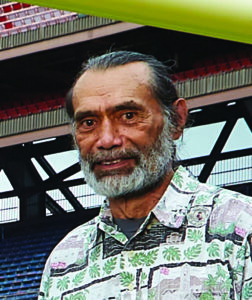 ‘Physical superiority cancels out all theories.’
‘Physical superiority cancels out all theories.’
Practices with Coach Price were so hard and so brutal that the games were easy by comparison.
Simeon Alo, a Kamehameha Schools graduate, anchored the Hawai‘i defensive line as a defensive end from 1969 to ’70 and 1972 to ’73.
He got a scholarship through Coach Price to play football at UH in 1969, and as a freshman rookie, made the travel squad as a versatile player on a variety of vital defensive teams.
 “Levi Stanley, a Waianae High School graduate, and I made every mainland trip,” says Simeon. “It was an honor because we were only freshmen.” Simeon and Levi were unable to play in 1971, but returned in 1972.
“Levi Stanley, a Waianae High School graduate, and I made every mainland trip,” says Simeon. “It was an honor because we were only freshmen.” Simeon and Levi were unable to play in 1971, but returned in 1972.
“Levi and I really enjoyed ourselves out there. What we managed to accomplish is a tribute to Coach Price. He really got us in shape.”
“Among Coach Price’s many pearls of wisdom, I remember he used to say, ‘Physical superiority cancels out all theory.’ In other words, if you are physically and mentally superior to who you are playing against, the game became easy,” says Simeon. “He made practices so hard that the games seemed easy!”
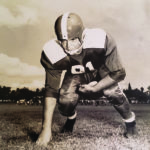 “Before you can play Division I, you’ve got to think Division I,” Coach explains. “In the early days, prior to Division I taking hold, the majority of the people we played were physically superior. UH was viewed as inferior to Division I opponents. Sports writers and newscasters used to laugh at us. So when people tell you that you are inferior, you got to prove them wrong. The first order of business was to convince them we were not inferior to anybody. This equated to hard practices.” The strategy paid off, making Price the UH’s first NCAA Division I head coach.
“Before you can play Division I, you’ve got to think Division I,” Coach explains. “In the early days, prior to Division I taking hold, the majority of the people we played were physically superior. UH was viewed as inferior to Division I opponents. Sports writers and newscasters used to laugh at us. So when people tell you that you are inferior, you got to prove them wrong. The first order of business was to convince them we were not inferior to anybody. This equated to hard practices.” The strategy paid off, making Price the UH’s first NCAA Division I head coach.
“I’ll never forget playing Grambling State University [La.]. The whole team was huge,” says Simeon. “The left tackle was 8 inches taller and weighed over 100 pounds more than I did,” recalls Simeon. Although the Warriors lost, Simeon’s opponent shook his hand after the game and said, “Bro, good game!” “It was out of respect. ‘Ask no quarter, none given.’ That’s how we played.”
“I will be forever grateful to Coach for giving me the opportunity to play Division 1 football,” says Simeon. “He helped shape me into the man I am today.” “And I wouldn’t be here if it wasn’t for Coach Price,” Levi added. “I owe him my life.”
 ‘Come out and prove yourself.’
‘Come out and prove yourself.’
Coach Price’s influence and support indirectly impacted the course of Hawai‘i politics.
In 1965, Rick Blangiardi wrote a letter to UH inquiring if it had a football program. His father was being transferred to Pearl Harbor and he wanted to ensure he could play college football.
“If you want a scholarship to play football here, you are going to have to come out and prove yourself,” said Coach.
“My relationship with him started with that challenge,” says Rick. “The day that I met Coach Price was the day that changed my life forever. He had just finished playing football. He was a physical force of nature and a fearsome creature.”
Although Rick did prove himself, he returned to Massachusetts in 1966 when his mother became ill. He stayed, graduated and started his coaching career at the University of Connecticut. Then he got a letter from Coach offering him the opportunity to coach varsity linebackers .
“I made the decision to return to UH predicated on Coach Price, my relationship with him and my complete confidence and respect for him.”
After Rick got his master’s degree, he was offered a full-time job by Coach Dave Holmes. When Larry became head coach, he promoted Rick to associate head coach and defensive coordinator — Larry’s former job.
“Him influencing me to come back to Hawai‘i and giving me the opportunity, promotions and titles all tremendously shaped my life.”
Married and with a baby on the way, Rick’s coaching salary didn’t go far. At age 30, with Coach’s counsel, instead of accepting a higher-paying coaching position on the mainland, he accepted a sales position at KGMB TV. Ultimately, his love of Hawai‘i kept him here. “I knew I would never coach with anybody better than Coach Price, which lessened the pain of leaving coaching.”
“It all goes back to how Coach perceived, supported and believed in me. That has continued throughout my entire career. He is a powerful force; he was my mentor. I have a reverence for him. I learned so much from him that has served as guiding principles in business and in life. He helped me lock in my belief systems that have carried forward throughout my life. To this day, I can’t call him Larry… it’s always Coach Price.”
Now 74, Rick is the current mayor of the City and County of Honolulu. “I wouldn’t be here today if it wasn’t for him,” says the mayor.
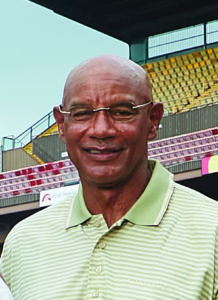 ‘If you cut me, I bleed green and white.’
‘If you cut me, I bleed green and white.’
Coach attained an amazing level of excellence at everything he did. From the outside, it did not look like a pursuit — it was simply an acquisition.
George Lumpkin was a defensive back in 1970 and ’71, when Coach was the defensive coordinator. After his player eligibility came to an end, George became a graduate assistant. When Coach became head coach in 1974, he made George a full-time coach.
“He was a great disciplinarian, but at the same time, he had a soft heart. The players just loved him because of who he was as a person. The harder he disciplined them, the more they loved him. They knew the drills were for their own good. They loved him because they knew that he cared about them as people, not just players. He was an outstanding coach, but probably an even better person. If a player needed help outside of football, he was there for them. He would give you the shirt off his back.”
“He was very good at everything he touched — chess, martial arts, slack key guitar and much more — not only football. He seemed just naturally exceptional at it all. But he has always been a humble guy, not talking about himself or patting himself on the back.”
“He was always moving forward — always thinking outside the box. ‘Nothing is as dead as yesterday’s football hero,’ he said. ‘You have to always stay on top of your game. People are quick to forget what you have accomplished.’”
“He’s an amazing person. The players are also really great people with good hearts who ended up doing good things. I think Coach Price had a lot to do with that. Many of his former players credit him for their successes in life.”
“We would do anything for Coach and he would do anything for us. We knew that without a doubt. ‘If you cut me, I bleed green and white,’ he used to say.”
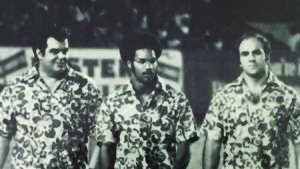
The Coach’s Playbook
A good coach tells you what you don’t want to hear and shows you what you don’t want to see, so you can be who you have always known you could be. A great coach makes you do what you don’t want to do — what you think is impossible — and makes you into someone better than you ever dreamt you could be.
Coach Price, who extolled the virtues of hard work and its rewards, influenced others through the example of his own hard work. He loved and respected his players and coaches. “They all worked hard and were willing to put in what was needed to accomplish the mission,” says Coach.
“Knowing I played for Los Angeles Rams must have helped convince them they could get to that level, too.” After completing two degrees, Coach became a free agent, multi-position player for the team. He was also sought-after as a coach, but Coach Price would not leave his beloved Hawai‘i.
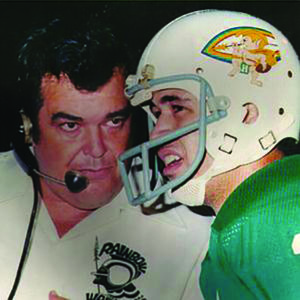 He has left an indelible mark on the hearts, minds and lives of those who knew him. As Dexter said, Coach Price and Assistant Coach Rick Blangiardi provided his players with “a book of everything we needed to be successful in life.” Coach’s former football players and staff will continue to turn to the pages of his playbook for success for the rest of their lives.
He has left an indelible mark on the hearts, minds and lives of those who knew him. As Dexter said, Coach Price and Assistant Coach Rick Blangiardi provided his players with “a book of everything we needed to be successful in life.” Coach’s former football players and staff will continue to turn to the pages of his playbook for success for the rest of their lives.
Coach enjoys an occasional round of golf at Waialae Country Club, where many of his former players meet with him.
Coach Price continues to champion up-and-coming athletes to “give them a place in the game” through the Oahu Interscholastic Association, and brings revitalized recognition to the state’s accomplished athletes through the Hawai‘i Sports Hall of Fame.
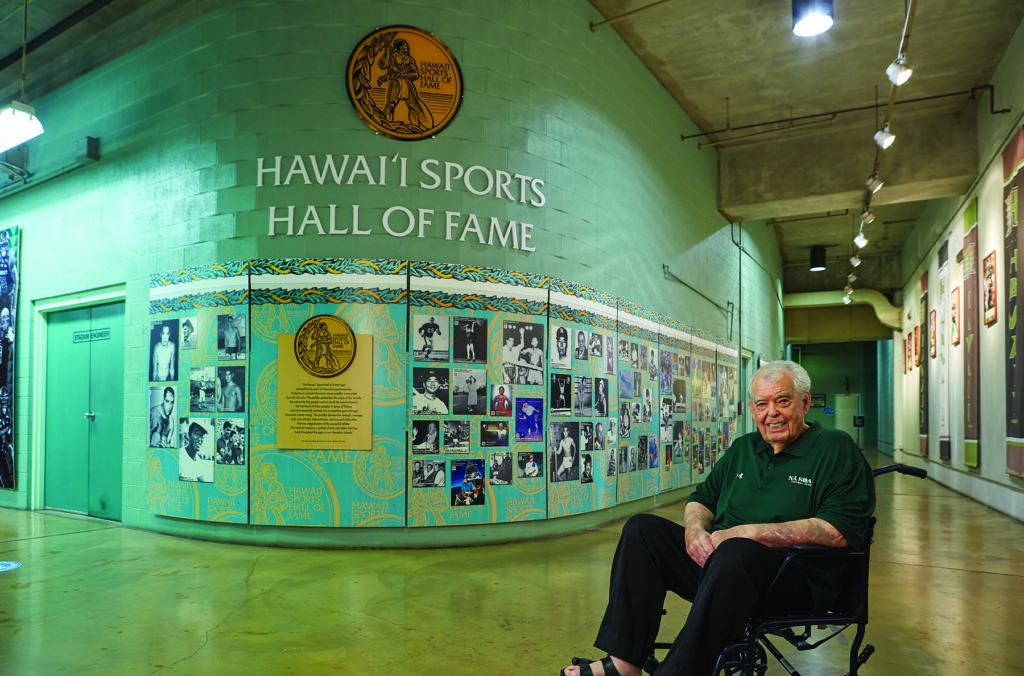
HAWAII SPORTS HALL OF FAME
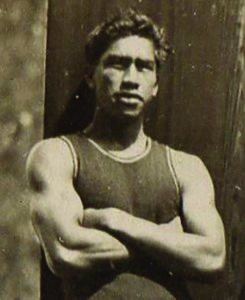
As with his football meritocracy, Coach Price felt meeting high standards with hard work, excellence and integrity should be rewarded and recognized, so he set out to rejuvenate the Hawai‘i Sports Hall of Fame.
“Because Hawai‘i is so remote, our athletes had not gotten the attention they deserve,” says Coach. “Hawai‘i has produced many young talented athletes and Olympian-level athletes who have gotten no recognition,” Coach said to the group. “We have enough to warrant honoring them and holding them up as role models for future generations of athletes.”
Although a hall of fame was already in place, it was not being used to its full potential. Coach breathed life back into the HSHOF, which now serves as “an educational repository to honor athletes, pioneers and contributors of Hawai‘i’s rich sports history and to serve as role models for our youth, encouraging them to emulate the same characteristics of devotion, dedication, pursuit of athletic excellence, steadfast and moral character.”
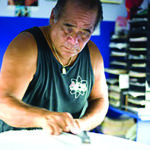 The first year was spent catching up by adding about 30 athletes who should have been included, starting with Duke Kahanamoku. A huge banquet was held to honor the overdue inductees. After the first five catch-up years, three or four athletes have been inducted per year.
The first year was spent catching up by adding about 30 athletes who should have been included, starting with Duke Kahanamoku. A huge banquet was held to honor the overdue inductees. After the first five catch-up years, three or four athletes have been inducted per year.
Those inducted last year bring the total number of Hawai‘i Sports Hall of Fame members to 158. Coach says, “The 2020 inductees span a wide variety of pursuits, exemplifying Hawai‘i’s unique and profound impact on the sports world. It is no small thing to be accepted into this elite group. Criteria for induction is strictly adhered to.” Selection is made with due process — a what-you-do process. The selection committee is made up of sports media members. “They write stories about these athletes, so they know who is who,” says Coach.
 “My message to young athletes is just to keep on going,” says Coach. “If you come up against a hurdle, overcome it and go on to the next hurdle until you don’t have any hurdles left.”
“My message to young athletes is just to keep on going,” says Coach. “If you come up against a hurdle, overcome it and go on to the next hurdle until you don’t have any hurdles left.”
Coach Price, a constant presence as chairman of the board, is transitioning the management of the organization to new leadership who will continue to solicit new inductees and ensure they meet the HSHOF’s stringent qualifications. Hawai‘i’s world-class Aloha Stadium houses a public displays of Inductee photographs and profiles. The Bernice Pauahi Bishop Museum is home to the flagship exhibition for the hall, and includes inductee photographs, profiles and memorabilia.
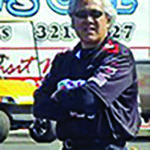 In addition to the permanent display venues, the HSHOF also maintains portable display screens with a full complement of the inductee photographs and profiles. This “traveling” hall of fame is used at events such as the Annual Induction Banquet and the Hall of Fame Golf Tournament. Arrange a tour of the HSHOF by calling the Aloha Stadium Office.
In addition to the permanent display venues, the HSHOF also maintains portable display screens with a full complement of the inductee photographs and profiles. This “traveling” hall of fame is used at events such as the Annual Induction Banquet and the Hall of Fame Golf Tournament. Arrange a tour of the HSHOF by calling the Aloha Stadium Office.
HAWAI‘I SPORTS HALL OF FAME
To arrange a tour, contact the Aloha Stadium office:
808-483-2500, Mon–Fri, 8am–4pm
alohastadium@hawaii.gov
For HSHOF nomination and donation information:
www.hawaiisportshalloffame.com
Executive Committee President Calvin Nomiyama:
admin@hawaiisportshalloffame.com

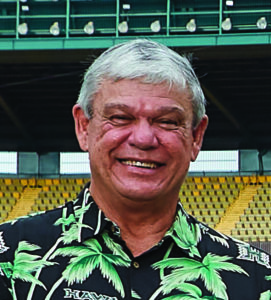

Leave a Reply